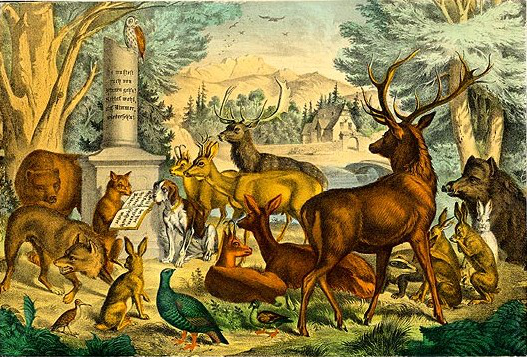Read the previous part here…
अयंनिजःपरोवेतिगणनालघु-चेतसाम्।
उदार चरितानांतु वसुधैवकुटुम्बकम्॥
ayaṃ nijaḥ paro veti gaṇanā laghu-cetasām |udāra-caritānāṃ tu vasudhaiva kuṭumbakam || 37 ||
This is mine, and that is yours – such thinking is for lowly minds. Minds that are noble and wise, think of the entire world as one family.

We all have read the Panchatantra.
Well, maybe not in totality, but in some shape or form.
These stories make their appearance in over 50 languages, and over 200 versions. Yes, the Panchatantra is the most widely-translated piece of Indian literature, and spread at an earlier time and more extensively that even the Srimad Bhagavad Gita. It demonstrates the richness of katha-parampara – the ancient Indian art of storytelling – that dates back to the Vedic age.
All good. But which version did you read exactly?
Most of us read the ‘stories’ – the clever jackal, the brave hare, the stupid fish and so forth. Simple stories with animal characters (and the occasional human) with a moral at the end of it. So I can imagine your surprise when you started to read the ‘real’ Panchatantra – with stories of deceit and corruption, illicit affairs and devious plots…and you must have wondered…how is this a children’s book?
Well, it isn’t.
Not to say that kids cannot read the Panchatantra, but it was not meant to be a kids-exclusive. Far from it.
The Panchatantra is a tantra, a shāstra. Specifically, a नीति शास्त्र – Nītiśāstra. Very tough to define this, but essentially it is a system of morals (social, economics and political). Nītiśāstra gives practical advice as to social well being.
The Panchatantra is not a good story book, with happy endings and smiling faces at the end of it. In fact, in the first (and longest) tantra, the protagonist with shades of grey – Damanaka, has his way and enjoys the spoils of his ill-gotten victory.
And this is part of the reason why the Panchatantra has survived over the millennia and grown in popularity. It is REAL. It shows us the beauty of life, with all it’s contradictions – happiness and sadness, richness and poverty, kindness and cruelty, goodness and evil…and it refuses to take sides. Rather, it leaves you with the choice of making the decision. It does show you what happens when a decision is made, but doesn’t preach to you.
Panchatantra is the moral science class that we all wanted, but never got.
The beauty in this shāstra lies in the Sanskrit padās, or verses, that are largely shubashitas, or ‘words of wisdom’ that existed in ancient India both in the collective memory of the educated classes and in anthologies of such verses made by various authors from time to time.
I will be putting together a list of my personal favorites, but the one that I started this blogpost with is the most quoted. Even if it is just quoted in part – वसुधैवकुटुम्बकम् – the world is one family. Not many know the origins of this quote (now you do), nor the context, nor the fact that the quote comes right after one that speaks of prostitutes (now you surely didn’t know that!). Read this blogpost to know more.
That being said, what did I learn from it?
The title of my blogpost gives it away. Writing about the Panchatantra opened a whole new world to me, one what stayed with me for over half a year, and 165 posts. I had to research a lot, reading over the Sanskrit original, multiple English translations and Hindi translations as well (since English sounded pretty ridiculous in many places), comparing interpretations and coming up with my own, correcting transliterations and editing a few parts that were aberrations in an otherwise complete piece of work.
And then, all of a sudden, an abrupt end yesterday.
Fun fact – I never made corrections when writing – I just wrote. No backtracking, no review. Write, publish with the mistakes, and then go read it to my wife. That’s where I would spot the mistakes (I have an eye of a copywriter), and then go back and correct them. A few may have given me the slip, and so a task (among many) that remains, is the detailed review, copywriting, and then publishing (yes, this will go to book form, and FREE) – hence the beginning, and not the end.
But more importantly, it enriched me. As a person, as a writer, as a reader, and as a lover of tradition. What a rich tradition they left back for us…one that we are currently reducing to tick-tock videos and tacky You Tube. We even managed to take out the very essence of the Panchatantra, by skipping the Sanskrit padās, editing the core of the stories (the story-within-a-story format), and presenting a vastly underwhelming result – that does not contain anything but a hollow shell of nothingness.
In my own words, that will only be understood by a relevant few – सारा रस निकाल गया, रह गया सिर्फ़ गुल्ला!
So this is the beginning. Started with the Panchatantra, but I will try to bring forth many such stories, and concepts, that were given to us, but have been forgotten in the cacophony of Halloween and Instagram filters. Not saying that one should not embrace the new, but surely not at the cost of the old.
This is as true for relationships, as it is for life itself.
अणुभ्यश्च महद्भ्यश्च शास्त्रेभ्यः कुशलो नरः।सर्वतः सारमादद्यात् पुष्पेभ्य इव षट्पदः।। – Skilled people learn from every source, be it big or small, much like honey bees, who collect nectar from all types of flowers.
I aim to be that bee, and I invite you to hum together on the way to our next flower…वेतालपञ्चविंशति – Vetala Panchavimshati – better known as the stories of Vikram and Betaal, starts tomorrow!
